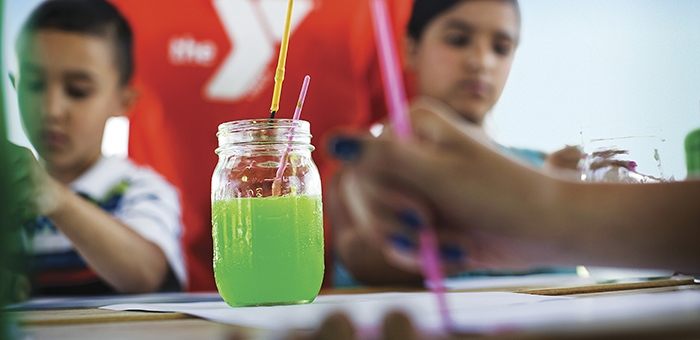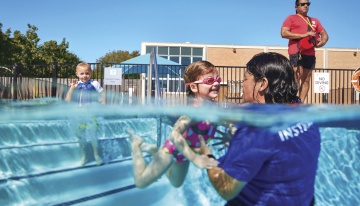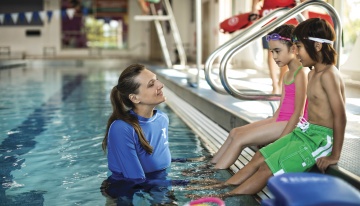Three Simple Outdoor Art Activities for Kids
Art is so much more than just a fun activity for youth. When kids are creating, they are also boosting self-confidence, practicing decision-making skills and improving fine motor skills. Plus, arts activities are a simple and cheap way to spend a rainy day at home or camp and to appeal to introverted campers.

Here are three art activities guaranteed to foster creativity:
1. CREATE YOUR OWN INSECTS
What you’ll need:
- Small twigs, leaves, small pebbles/rocks found in nature (consider collecting items on a walk or hike prior to activity)
- Possible materials (provide a variety for youth to create with)
- Dried out seeds
- Beads
- Sequins
- Buttons
- Cotton balls
- Pipe cleaners
- Aluminum foil
- String or yarn
- Popcorn kernels
- Colored paints
- Glitter glue
- Permanent markers
- Paintbrush
- Scissors
- Paper plate
- Tacky glue or glue gun (glue gun requires adult assistance)
Instructions:
- Begin activity talking about insects—possibly about some that were observed during a group hike or ask youth to share information about their favorite insect.
- Share some characteristics of insects—for example, insects have a three-part body, three pairs of jointed legs, compound eyes and one pair of antennae.
- Ask youth to think about what “new” insect they would like to discover. What would it look like? What would it feel like? What might its habitat look like? Would it have a special survival skill?
- Now each youth gets to bring their newly discovered insect to life! Using the variety of materials provided, invite the youth to choose what they would like.
- Provide different colored paint options as needed.
- Adults will need to assist youth if using a hot glue gun or instead, use tacky glue to put the finishing touches on their insects. Once all of the insects have been created, ask them to name their insect and share a fun story about their new discovery to a friend!
2. TIE-DYE ROCKS
What you’ll need:
- Different sized smooth rocks and stones
- Colored acrylic paints
- Baking cooling rack
- Cardboard box or tray (larger than baking cooling rack) for run-off paint
Instructions:
- Wash and clean the rock or stone and allow it to dry.
- If using a cardboard box, keeping the bottom intact, an adult should cut the height of the box to two inches above the height of the baking cooling rack all around the box.
- Insert the baking cooling rack into the box or tray. The box/tray will collect all of the run-off paint for easier cleanup.
- Multiple youth can tie-dye their rocks at the same time using the same baking cooling rack.
- Pick one color of paint to start and squeeze a generous amount onto the rock. Once a puddle of paint forms, pick another color and layer it on top of the first color. You can choose how much of the first color you want to layer with the next color. Repeat this process with as many colors as you’d like until the top of the rock is covered with paint.
- As youth are creating their tie-dye rocks, talk about color combinations, primary colors or testing certain techniques and the resulting designs.
- Allow rocks to dry.
- Tie-dye rocks make great paperweights, gifts or outdoor décor!
3. MAKE CLOUD ART
What you’ll need:
- Table salt
- Thick black cardstock paper
- Watercolors
- Paintbrush
- Cup of water
- White glue
- Tray or baking sheet
- Hairspray (optional)
Instructions:
- Preferably on a partly cloudy day, have the kids lay on the grass and observe the different types of clouds in the sky.
- Ask questions like, “how would you describe how the clouds look?”, “how do you think the clouds feel?” or “what animals or objects do the clouds look like?”
- Share some general information about clouds: a cloud is a large collection of very tiny droplets of water or ice crystals. The droplets are so small and light that they can float in the air. There are many types of clouds including cirrus, cumulus and stratus. Discuss what each type of cloud looks like.
- Now it’s time to create a cloud creation!
- Using glue, draw the cloud creation—it could be an animal, a landscape, fireworks or anything that the kids would like. The thicker and more glue, the better!
- Sprinkle salt over the glue—do this before the glue dries and make sure all of the glue is covered generously with salt. Shake off the excess salt onto the tray or baking sheet.
- Get the paintbrush really wet with water and use the watercolors to color the salt. Be sure to use the paintbrush gently over the salt so the salt doesn’t drag. First, just tap the tip of the paintbrush onto the salt. Rinse the paintbrush with water when switching to another color.
- Allow the cloud creation to dry.
- Optional: once it’s dry, spray the artwork with hairspray to help it last longer.




